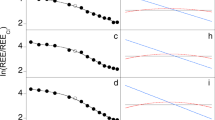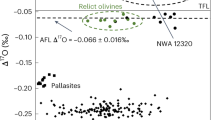Abstract
The (U+Th)/He dating method is the oldest method of geochronology that involves radioactivity, but historically it has not been particularly successful. Even when problems of poor helium retention and loss due to radiation damage are circumvented by analysing suitable mineral phases1–4, problems frequently remain with inherited helium5,6. Here we show that isotope disequilibrium in the 3He/4He ratio between helium trapped in vesicles and that dissolved in the glass phase of some young seamount basalts can be used to determine (U + Th)/He ages for the basalts. We use the 3He/4He in vesicles (extracted by crushing in vacuo) to correct the dissolved phase He (by fusion of the remaining powder) for the inherited component, and compute the radiogenic helium concentration. The method is applicable to rocks containing phases with different (U+Th)/He, and the results have implications for dating lavas in the age range of 103 to 106 years (thus filling a gap between the limits of the 14C and K–Ar methods), and for reconstructing the geochemical history of young volcanic systems.
This is a preview of subscription content, access via your institution
Access options
Subscribe to this journal
Receive 51 print issues and online access
$199.00 per year
only $3.90 per issue
Buy this article
- Purchase on Springer Link
- Instant access to full article PDF
Prices may be subject to local taxes which are calculated during checkout
Similar content being viewed by others
References
Keevil, N. B. Amer. J. Sci. 241, 680–693 (1943).
Hurley, P. M. Geol. Soc. Amer. Bull. 61, 1–8 (1950).
Fanale, F. P. & Kulp, J. L. Econ. Geol. 57, 735–746 (1962).
Damon, P. E. & Green, W. D. in Proc. on the Symposium on Radioactive Dating (Int. Atomic Energy Agency, Vienna 1963).
Damon, P. E. & Kulp, J. L. Amer. Mineral. 43, 433–459 (1958).
Noble, C. S. & Naughton, J. J. Science 162, 265–267 (1968).
Zindler, A. et al. Earth planet. Sci. Lett. 70, 175–195 (1984).
Batiza, R. & Vanko, D. J. geophys. Res. 89, 11235–11260 (1984).
Graham, D. W. et al. EOS 65, 1079 (1984).
Batiza, R. & Vanko, D. Mar. Geol. 54, 53–90 (1984).
Kurz, M. D. & Jenkins, W. J. Earth planet. Sci. Lett. 53, 41–54 (1982).
Kurz, M. D., Jenkins, W. J. & Gurney, J. J. Earth planet. Sci. Lett. (in the press).
Steiger, R. H. & Jager, E. Earth planet. Sci. Lett. 36, 359–362 (1977).
Morrison, P. & Pine, J. Ann. N.Y. Acad. Sci. 62, 69–92 (1955).
Mamyrin, B. A. & Tolstikhin, L. N. Helium Isotopes in Nature (Elsevier, Amsterdam, 1984).
Andrews, J. N. Chem. Geol. 49, 339–351 (1985).
Jambon, A., Weber, H. W. & Begemann, F. Earth planet. Sci. Lett. 73, 255–267 (1985).
Marty, B. & Ozima, M. Geochim. cosmochim. Acta 50, 1093–1097 (1986).
Newman, S. et al. Earth planet. Sci. Lett. 65, 17–33 (1983).
MacDougall, J. D. et al. Earth planet. Sci. Lett. 42, 27–34 (1979).
Bender, M. L. thesis, Columbia Univ. (1970).
McNutt, M. J. geophys. Res. 91, 3686–3700 (1986).
Jochum, K. P. et al. Nature 306, 431–436 (19833).
Author information
Authors and Affiliations
Rights and permissions
About this article
Cite this article
Graham, D., Jenkins, W., Kurz, M. et al. Helium isotope disequilibrium and geochronology of glassy submarine basalts. Nature 326, 384–386 (1987). https://doi.org/10.1038/326384a0
Received:
Accepted:
Issue Date:
DOI: https://doi.org/10.1038/326384a0
This article is cited by
-
Paroxysmal eruptions tracked by variations of helium isotopes: inferences from Piton de la Fournaise (La Réunion island)
Scientific Reports (2020)
-
Constraints on mantle melting at mid-ocean ridges from global 238U–230Th disequilibrium data
Nature (1996)
-
Geological and petrologic evolution of seamounts near the EPR based on submersible and camera study
Marine Geophysical Researches (1989)
-
New field and laboratory evidence for the origin of hyaloclastite flows on seamount summits
Bulletin of Volcanology (1989)
-
He, Pb, Sr and Nd isotope constraints on magma genesis and mantle heterogeneity beneath young Pacific seamounts
Contributions to Mineralogy and Petrology (1988)
Comments
By submitting a comment you agree to abide by our Terms and Community Guidelines. If you find something abusive or that does not comply with our terms or guidelines please flag it as inappropriate.



